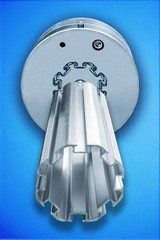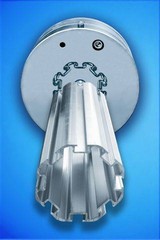Extrusion (Pressing)
Thanks to modern technology, the quality of the profiles is better than ever. From our largest extrusion line, we produce aluminum profiles with a power of 35 MN. We can manufacture profiles up to 640 mm wide.
In extrusion, a heated aluminum ingot is cut to the right length for press and profile shape. Then the ingot is pressed through the tool like a sprit and the finished profile comes out on the other side. Depending on the size, you can have several similar shapes in the tool to optimize the process. The profile is then cooled down quickly with the help of air or water.
Once the profile has cooled, it is stretched to make it straight as well as release any tension. At this stage, the profile is approximately 50 m long. Then, it is cut down to the desired lengths. After this, it is aged to achieve the desired hardness. The profile is then shipped to the customer or onwards for further processing.
Surface treatment
Surface treatment further increases the potential of the material, creating both beautiful and durable surfaces. Our surface treatment plants specialize in powder coating and anodizing of aluminum, which increases its natural corrosion resistance and total durability.
Powder coating - colorful possibilities and a durable surface
Powder coating provides excellent mechanical and chemical resistance while offering a wide range of colors. The RAL color scale is the one most commonly used but the NCS color scale can also be used. The details are pre-treated for varnishing with an environmentally conscious and chrome-free pre-treatment to improve adhesion and bonding of the paint. The requirements for the painted surface affect the choice of powder type. Polyester powder is weather resistant and does not turn yellow in UV light and heat. Since 2001, our powder painting plant has met the requirements of the German GSB standard.
Anodizing improves appearance and the corrosion resistance
Anodization is a surface treatment method used on aluminum to form an oxide layer on the surface using electrochemical methods. In the anodization process, the details are immersed in an electrolyte solution. As an electric current passes through the solution, oxygen is released. This creates a reaction with the aluminum, forming the desired thickness of oxide layer on the surface. The thickness and properties of that layer can be regulated by changing the electric current, operating time and composition of the electrolyte. The resulting surface is extremely hard, dense and durable, and reinforces the natural metallic surface.
We use two different anodizing methods:
- Natural anodization (LV) for indoor and outdoor use, one shade and multiple various layer thicknesses.
- Electrolytic color anodization (ES) for indoor and outdoor use, seven standard color tones.
Other colors can be delivered by request.



